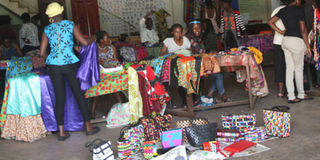Real life projects helping to assess learning outcomes in vocational training

Vocational training students displaying their creations during an exhibition and assessment exercise. Real life projects give vocational students and edge in knowing how the market dynamics work. COURTESY PHOTO
Skills training largely depends on practice. Students learn more when they are given opportunities to put into practice the things they have learned and this is what makes vocational and technical education and assessment different.
Uganda Business and Technical Examinations Board (UBTEB), the examining body of vocational, technical and business institutions, uses real life projects as a way of assessing student competences in addition to continuous assessments, standardised national exams and industrial training.
The board also provides the assessment guide to the institutions to use during supervision and marking exercises of these real life projects.
Diana Ariva, a tailoring, fashion and design student at Management Training Advisory Center (MTAC) says although there is a lot of anxiety involved when working and putting together projects for exhibition, it encourages students to work hard.
“When I was working on my projects where we had to create products for all the skills we had been learning such as, sewing, making jewelry, printing designs, embroidery and textiles, I had to find out what other people in the industry were doing so that my products could stand out. I invested time and creativity.
Exposing students’ work
Furthermore, Ariva notes that real life projects are good because they expose the student to the world. “As we showcased our products for the assessment, the public was welcomed. When customers see your products and even buy them, they get to know you and what you are capable of making. Academically, we are awarded marks according to the quality of our products.”
Real life projects also instill confidence in students. Godfrey Kasaadha, a motor vehicle mechanics student at Nile Vocational Institute, says, “It gives you confidence when you can actually do something tangible, like making a machine work again. Actually, if it is possible, vocational institutions need constant projects on which students can dedicate their time and skills, not just as a way of assessment, but to develop their abilities.”
The exhibitions are a great way of showing learning outcomes but also assessing the quality of teaching and learning. At these exhibitions, parents can also get the opportunity to appreciate what their children have been doing since they joined vocational institute.
Patrick Ejom, an instructor at Hakitengya Community Polytechnic, says, “Students are tasked to handle projects according to their different courses. For example, construction students can work on a project of building a house or carpentry students are tasked to produce furniture. Instructors supervise them throughout the project. That way, we ensure quality and guide students accordingly, pointing out their weak areas, the mistakes and encouraging their strong points.”
Vital Voice
Students come in without hands-on knowledge and because this is a skills programme. We have to assess them basing on the products they make.
Vocational skills are not something you just talk about, but one should be able to display their skills and that is what we assess.
According to the products that the students make, we can assess their level of creativity, marketing skills, displays, customer care according to how they interact with people who visit their stalls, and in the end, they are able to go out into the world and do something with their hands.
Exhibitions are also an eye opener to the students about the competition they will find in the outside world and how the real market works.
Ritah Nakiganda
Fashion and designing instructor, MTAC.




